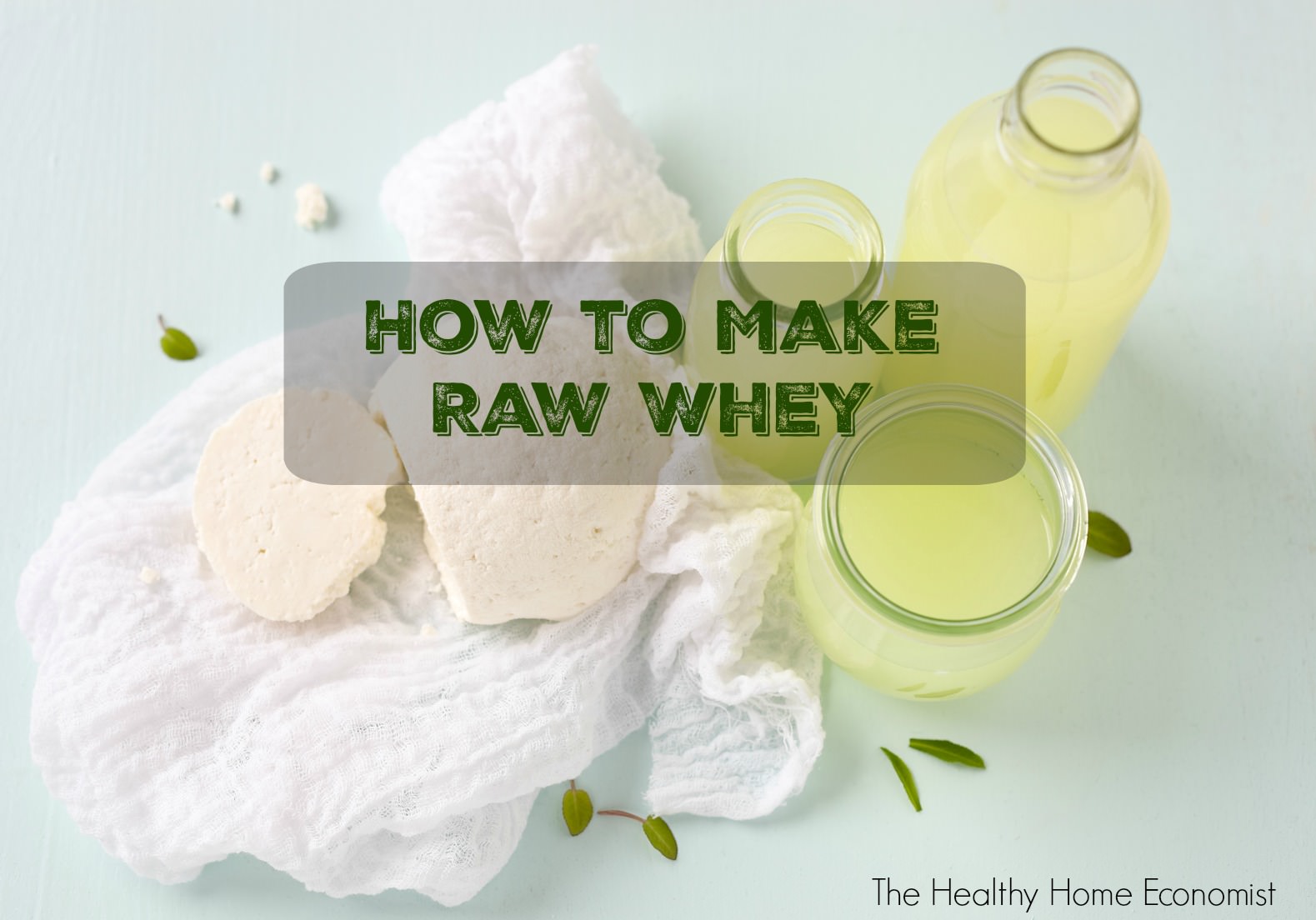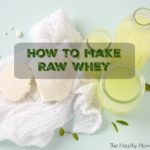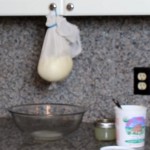How to make raw, enzyme and probiotic-rich liquid whey to use as a starter culture for all your home fermentation needs.

Do you know how to make whey from yogurt, kefir or raw milk?
A by-product of this simple technique is healthy homemade cream cheese that is loaded with enzymes and probiotics.
The recipe below describes how with visual instructions via video demonstration!
Making homemade baby formula? I recommend using this “quick whey” no straining method as the fastest and easiest approach.
How to Make Whey the REAL Way
Making real, liquid, nutrient rich, unadulterated whey in your own kitchen is a MUST step for any traditional cook to learn.
Without whey in its whole, liquid form, many other traditional recipes cannot even be attempted. You cannot buy whey from the store except in a denatured, unhealthy, powdered whey form. It is worth your time to learn what I show you in the video below.
Other video lessons on this blog show you how to use this whole food form of whey to make many delicious, healthful recipes for your family. Whey as made in the video demo below will keep up to 6 months in the refrigerator in a sealed mason jar.
If you absolutely have no access to farm fresh milk to make whole, unadulterated, enzyme rich whey, then you can use plain, organic yogurt brand from the store instead. Here are tips on how to spot the best yogurt brands.
The process is basically exactly the same thing as shown in the video.
You won’t get nearly as much whey using yogurt as clabbered, farm fresh milk, but at least you can get enough to get you started.
Wonderful Whey and REAL Cream Cheese
The raw, enzyme-rich cream cheese I make in the recipe video below is fantastic on a sprouted or sourdough bagel for breakfast. Don’t buy the Ezekiel sprouted muffins as they contain soy. This low-carb bagel recipe is another great one to try.
If you prefer to buy, these sourdough bagels are available for shipping freshly made to your door.
To make, just take your cream cheese left over from making liquid whey and add a few strawberries and a dash of dark maple syrup to taste. Mix together by pulsing a few times in your food processor. This wonderful, fresh, REAL strawberry cream cheese will last one to two weeks in the refrigerator. Another wonderful use for this healthy raw cheese is to make an easy no bake cheesecake.
No access to raw milk where you live? No problem. Check out this recipe plus video on how to separate whey from yogurt purchased from the store.
Cloudy Whey vs Clear Whey
No matter whether your whey turns out cloudy or clear, it is safe and fine to use in all your favorite recipes. This article explains why sometimes whey is cloudy compared to its usual golden color.

Raw Whey Recipe
How to separate raw, liquid whey from clabbered milk. The process also creates probiotic rich cream cheese.
Ingredients
- 1 quart raw milk preferably grassfed
- 1 large glass bowl
- 1 large rubber band
- 1 white dishtowel
Instructions
-
Allow the raw milk to sit on the counter for 1-3 days at room temperature.
-
When the milk separates into curds and whey (transforms into clabbered milk) you are ready to proceed. Note that the fresher the raw milk and the colder the temperature of your house, the longer it will take the raw milk to clabber.
-
Line a clean, large glass bowl with a clean, white dishtowel that isn’t too thick. Cheesecloth will also work, but the holes in the mesh must be very small, else the milk curds will pass through.
-
Gently pour the clabbered milk into the middle of the dish towel. Gather up the ends and fasten with a rubber band. Attach to a knob on an upper cabinet in your kitchen as shown in the picture.

-
Let the raw whey drip into the bowl underneath. This process will continue for an hour or two.
-
After the dripping stops, gently take down the hanging bag and place it into a clean bowl. Scrape out the raw cream cheese that is inside the bag, put in a container with a lid and refrigerate.
-
Pour the liquid whey from the dripping bowl into a glass mason jar, afix the lid and refrigerate.
-
Refrigerated, raw cream cheese will be good to eat for about a week. Raw whey will last several months refrigerated.
Recipe Video
How to Use Whey in Recipes
How to Make Ricotta Three Ways (plus Video How-to)
Perfect Probiotic Cottage Cheese
Cheese Making: Common Problems and Solutions








I’m trying to make whey from breastmilk to make fermented salsa. My baby is severely lactose intolerant so I have to stay away from dairy. Would it work the same?
I would suggest using raw ACV to ferment instead of whey if there is a dairy intolerance
I’ve spent the afternoon on the internet searching info about using the raw goat milk that separated in my fridge after sitting there for weeks. I have dumped it into cheesecloth to strain the whey.
I’m wondering why you call it cream cheese instead of cottage cheese. The same process and it is called both on different blogs. It looks nothing like cream cheese you buy in the store and I wonder if to get something like that to spread on a bagel you’d have to do more processing. I don’t even eat bagels, haha, but I’m just trying to figure out the differences in all of these cheeses. The internet, what a blessing and yet sometimes confusing place! 🙂
Here’s how you make cottage cheese as opposed to the cream cheese presented in this article 🙂 https://www.thehealthyhomeeconomist.com/traditional-probiotic-perfect-cottage-cheese/
I want to remove the cream from the cheese becouse my plan is weight loss………and i want to know if there is any fat with the liquid whey
Removing fat and cream from your diet won’t help with weight loss! That being said, the liquid whey is primarily the minerals, protein, probiotics, and sugar water from milk. There can be small amounts of fat depending on the separation process efficiency.
When I poured the clabbered out of the jar the curds seemed more solid than it appears on your video. Also, after I strained out the whey, I had two different textures remaining. One was a buttery color, very soft, the other was much whiter and more firm and spongey. I am assuming this was the cream, am I right? My question is, is this normal or did I do something wrong?
Clabbered milk can vary quite a bit from batch to batch. Yes, the cream is buttery colored.
Just to verify is it normal to have both a soft yellowish colored curd and a white spongy curd at the same time?
Yes, it’s just the cream separated from the milk as it clabbered.
Hi!
I am following your recipe for Homemade Baby Formula and need to select a Liquid Whey. I am a member of a Healthy Food Club and I have the following options available to me. Can you please let me know which would be best for the recipe? Thanks!
Cottage Cheese Liquid Whey
Cottage Cheese Liquid Whey
Goat Whey
Greek Yogurt Whey
Greek Yogurt Whey
This is NOT whey protein or anything similar.
This homemade liquid whey is made from separating the curds (cottage cheese) from the liquid (whey). It is never hotter than 90 degrees.
This whey is ideal to soak beans, nuts, and grains. Soak them with 2 Tbsp Whey plus warm water for 12-24 hours and discard water(keeping the water below 110 degrees to not kill the enzymes in the whey).
Soaking with whey will help neutralize the phytates and antinutrients more effectively, making them easier to digest. As a result, you will have softer beans that are partialy digested, and thus cause less gas. And your grains will also be easier to digest and easier to get nutrients and vitamins from after proper soaking.
I would choose the goat whey.
This is so cool! I am wanting to earn how to prepare my own healthy foods, and wanting to learn more about what foods are good for us, traditional methods that are almost lost now, etc. I just found your site today, through the permaculture email that I have been getting. I am eager to get your news letter, and I would love to be a part of your weekly assignments!
thank you so much!
Could you give more details as to why you can’t use regular milk from the grocery store. It will work in the sense that you will be able to get the grocery store milk to separate into whey and cream cheese but why is it not healthy for you made that way?
Because processed milk from the store is dead (no enzymes or beneficial probiotics left in it) from the high heat treatment and is a highly allergenic food as a result … processed milk from the store should never be given to a child let alone a baby. In addition, the processed milk from the store is from sick cows in confinement fed GMO grains and shot up with hormones and other antibiotics.
Hi Sarah,
I’m trying to make the whey for the baby formula. The first batch of whey I did was chunky like your video and I believe I did everything right. But the second batch I’m doing have been sitting out for 6 days now and a part of its chunky but still looks more like milk then anything. My question is: I buy a half gallon of raw milk, dump it into mason jars and then put the lids on them and store them in my room because it’s the warmest place in my house. Should I place tea towels over the top instead of the lids so air can get at them? Or is there lids fine?
Also I tried to make cream cheese out of the first batch and it was really sour and smelled horrible… Did I not leave it out long enough?
Thank you.
So you say that the air needs to be at 73 degrees for the milk to separate. Well I have a problem then… it is winter by me right now and my place is very poorly insulated. Even with my electric heaters running, it doesn’t get past 65 degrees inside. I have some raw milk that has been sitting out for nearly 2 weeks now. It separated a little bit and seems to have stopped. There is still a large layer of milk sitting underneath a small layer of whey. Do you have any suggestions on what I can do? Will it just take a lot longer to separate? Is it even still good at this point?
ok disregard the comment above. I just realized my milk has separated. For some reason I was expecting it to actually separate with the curdles sitting on top and the whey on the bottom. So now my concern is, it’s been sitting out for 2 weeks. Should I toss it?
Yes, if it is too strong or has mold on it.
How much liquid whey should be used in a smoothie to make it equivalent to the amount of powdered whey which is used in a smoothie?
I watched your video & then made approx. 1/4 cup of liquid whey using Krema plain yogurt purchased from a store here in Canada. You indicate it goes a long way so I assume it is concentrated, requiring maybe a teaspoon or so!
I’m anxious to try it!
Repeating an old reply from Sarah for those of us who cannot get raw milk and must resort to a pasteurized, cultured yogurt product we find in the store. (My best source for yogurt cream cheese/whey is Stonyfield FULL FAT plain yogurt.)
Sarah, The Healthy Home Economist May 7, 2011 at 5:00 pm:
Hi Cindy, the whey you’re using is not raw but it is still fine .. kind of the same thing that you would get if you strained the clear liquid off pasteurized store yogurt.
Definitely ok compared with powdered whey!